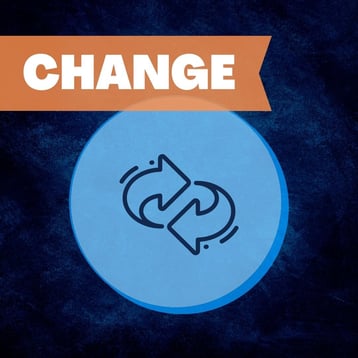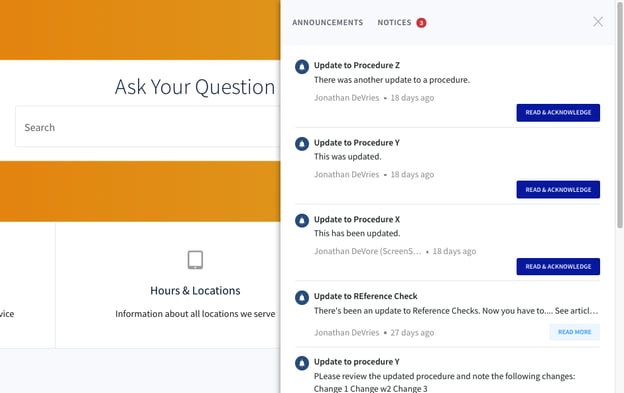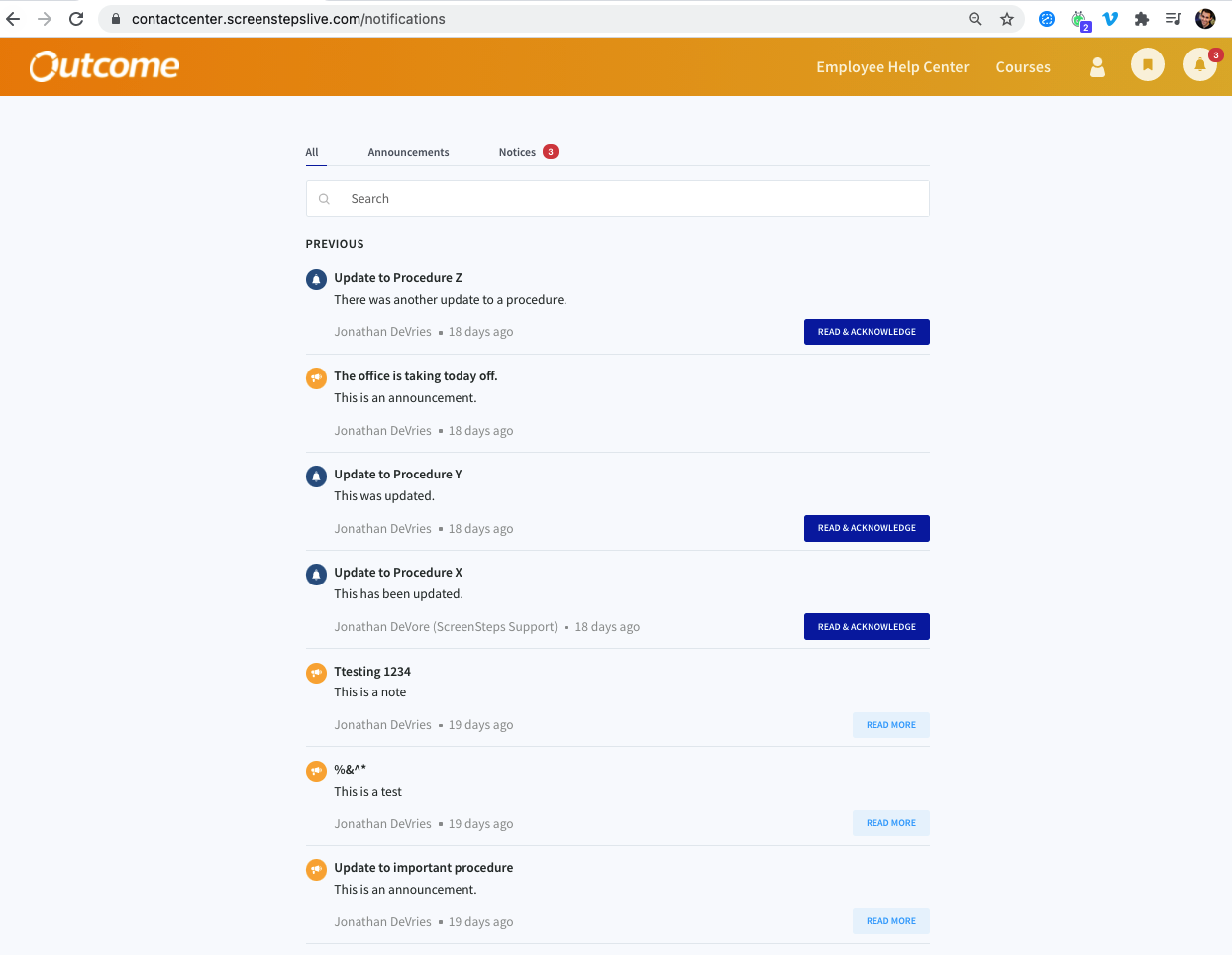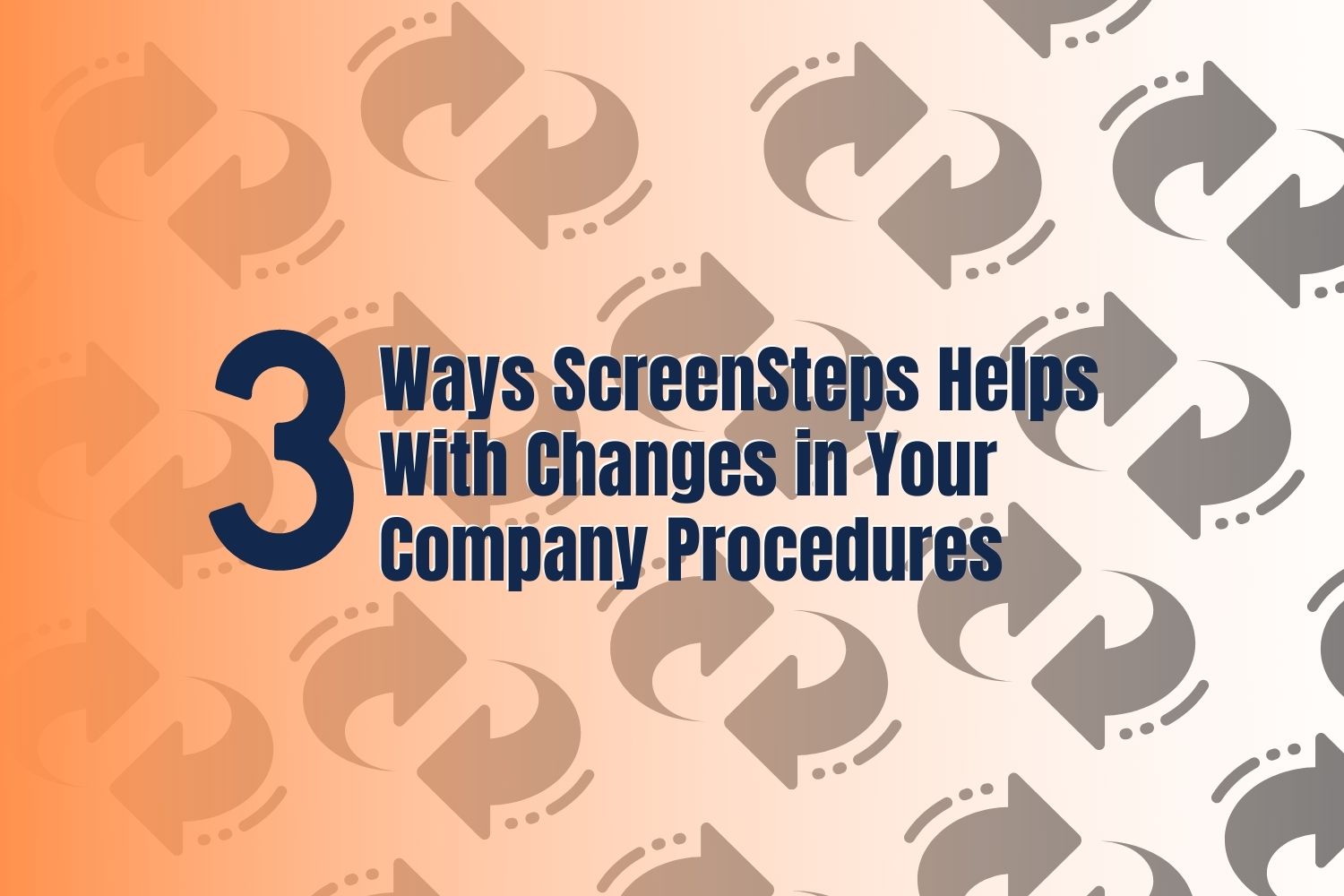3 Ways ScreenSteps Helps With Changes in Your Company Procedures
What is the “Change” Moment of Need?
The Change Moment of Need is one of 5 Moments of Need. The 5 Moments of Need is a methodology created by Bob Mosher and Conrad Gottfredson to help Learning & Development teams identify the learning opportunities for employees.
 You use the moment Change when employees need to learn to do something familiar in a different way. Another way to look at it is people are learning to do a known process or procedure in a slightly different way.
You use the moment Change when employees need to learn to do something familiar in a different way. Another way to look at it is people are learning to do a known process or procedure in a slightly different way.
If there’s a big change, it actually falls within the “New” Moment of Need. This includes introducing new processes that are unfamiliar to your employees or introducing new systems that are unfamiliar.
For the Change moment, you create learning assets that employees can use to understand and implement a change in a process or procedure.
3 types of changes
There are 3 different types of changes that your company will require updates/changes to your learning assets. These changes are small enough that they can be managed with updates to your existing documentation.
1. Minor changes
These have the smallest impact on your employees. They are changes to the information that is documented. These minor changes include changes to information such as phone numbers, addresses, interest rates, etc.
2. Changes to existing procedures
Another change is when you need to make slight changes to the order of steps in a procedure or insert a new step within the procedure. This could be as simple as switching the sequence of clicks in the procedure so that the steps flow smoother.
An example of this is when you need to make a slight change to a quote process. Your employees may be using two systems for billing management, and they are accustomed to creating quotes in billing system A, but now they need to use billing system B (a system your employees already use) to create quotes.
Your employees already know what a quote is, they know when to produce it, and they’re familiar with a general procedure. But the details of that procedure have been updated. Even though it is in a new system — since employees are already familiar with both systems — it’s nothing new. There’s just a slight shift in how employees will execute the quote creation task.
3. Introducing new procedures
The largest change you can make as part of Change learning assets is by introducing a new procedure.
This is still considered a moment of Change because employees are familiar with the system and overall process. The difference is that you are adding a new procedure (or another set of steps) in an overall process.
For example, processing a purchase order includes three procedures:
- Receiving a Purchase Order
- Creating an invoice
- Submitting the invoice
- Receiving a Purchase Order
- Confirming vendor is in/Adding the vendor to our vendor management system
- Creating an invoice
- Submitting the invoice
But due to new compliance requirements, you need to add another procedure in the process to remain compliant. So, you write out the new procedure for “confirming the vendor is in our vendor management system.” (It may be necessary to add the vendor to your vendor management system).
Then you insert it into the process. The new order is now:
Your employees have the basic knowledge to follow these steps without any classroom training.
How ScreenSteps helps in the moment of Change
As you create learning assets (aka help guides) for the moment of Change, you have a variety of ScreenSteps features to help you leverage these updates. Here are three strategies for using ScreenSteps to aid employees in the Change moment.
1. Communicate changes to your procedures
Even though your ScreenSteps articles will automatically be updated when you publish changes, you still need to inform your employees about those changes. ScreenSteps makes it easy to do that.
Send notifications to communicate changes
If you are making a minor update, you can send them a notification or an announcement. The notifications feature allows you to blast notices to your employees. Employees then have to click the “Read & Acknowledge” button to report that they’ve seen the notification.
You would use this feature when updating a procedure or introducing a new procedure as part of a familiar process.
Note: The notifications feature is only available with the Enterprise plan at this time.

Send an announcement
When you send announcements on ScreenSteps, employees don’t need to acknowledge that they’ve seen the message. You would use this for minor updates for new information (ie: phone number, insurance).
Here is a view of what a mix of announcements and notifications would look like in your employees’ ScreenSteps account.

Note: The announcement feature is only available with the Enterprise plan at this time.
Send emails to communicate changes
If you want to notify employees about changes outside of ScreenSteps, you could send an email or message them over chat. You would want to include the link to the ScreenSteps article in your note.
The downside is that employees may turn to their email or chat to find the guides, which is difficult to search.
2. Point people to the single source of truth
The learning assets for the Change moment of need are only useful if your employees are referencing the knowledge base regularly. Create a culture in your company where people are turning to your ScreenSteps knowledge base for answers.
For all the changes that you make to your processes and procedures, you want to point your employees to ScreenSteps to learn about those changes. That’s because ScreenSteps is serving as your company’s single source of truth. It’s where employees go to get information about your company.
How do you reiterate the importance of using the knowledge base to do their jobs? You create a culture of turning to your knowledge base by:
Keeping your guides up to date
If your employees start out using your guides but then those guides get outdated, they are going to stop using the guides. Why? Because those guides are causing them to make mistakes.
When you keep your guides up to date, those learning assets help train employees the right way to perform a task. It builds trust in your procedures and makes updating employees on changes easier in the future.
Answering questions by sharing links to articles
When employees forget to look at the knowledge base before asking leaders or fellow employees how to do something, don’t just answer the question. If you rewrite all the information in a chat message or email, you’re just doing the same work a second time.
Instead, respond with a quick message and a link to the article in your ScreenSteps knowledge base. If the employees still have questions, you may need to update your guide to clarify the procedure.
Referencing articles in lunch-and-learn
If you feel the need to do a lunch-and-learn to further explain changes, that’s fine. However, you will still want to point your employees to the knowledge base article during training.
Before the lunch-and-learn, create the ScreenSteps article. Then, during the lunch-and-learn, reference the knowledge base article. The goal, once again, is to drive them back to this article. They know where to find it and use it to address the situation.
🔍 Related: 5 Moments of Need: How to Write “Apply” Learning Assets in ScreenSteps
3. Update your articles with simple content creation tools
With the simplicity of updating articles in ScreenSteps, your employees can always have the correct information available to them in their guides.
To update an article, you go into the existing articles, make edits, and click publish. Updates are available to employees immediately after the changes are made and published. Even better, the old procedure is hidden.
Employees won’t accidentally pull up a procedure for “how to create a quote” version 2.5 when you are on version 3.1. That’s because older versions of the article are archived in the backend of ScreenSteps. Old versions are removed from employees’ view.
As you make these edits to your guides, the simple content creation tools make it quick and easy to make changes. The ScreenSteps tools allow you to add new text boxes, swap out screenshots, and add clarifying features (like foldable sections).
Plus, your formatting won’t get messed up like it does in Word because these features are broken into clear sections. As you edit one section, it doesn’t affect the others as it does in a Word document.
Make a plan to regularly review your content. For all the Change moments, your plan could be to update your articles with changes within 24 hours. (Really, those changes take less than an hour — sometimes minutes — with ScreenSteps.)
Prepare learning assets for employees to help in all their moments of need
Change is inevitable in business. If you prepare for changes to your processes and procedures, it will be easier to update your learning assets. These guides will keep your employees in the know and help them avoid mistakes.
With ScreenSteps, you can easily update your articles so that your employees always have current information. One of our users says they can now create 4X the content in ¼ of the time it used to take them.
If you need help creating a plan to update your content or writing Change articles, we have ScreenSteps coaches that can train you on the best tactics.
Half the battle is recognizing when your employees will need learning assets and what type of article will help them. Learn more about what type of articles you can write for your ScreenSteps knowledge base to address the 5 Moments of Need.


.png)
